Jaguar F-Pace 4x4 (2016-2024) engines, drive and performance
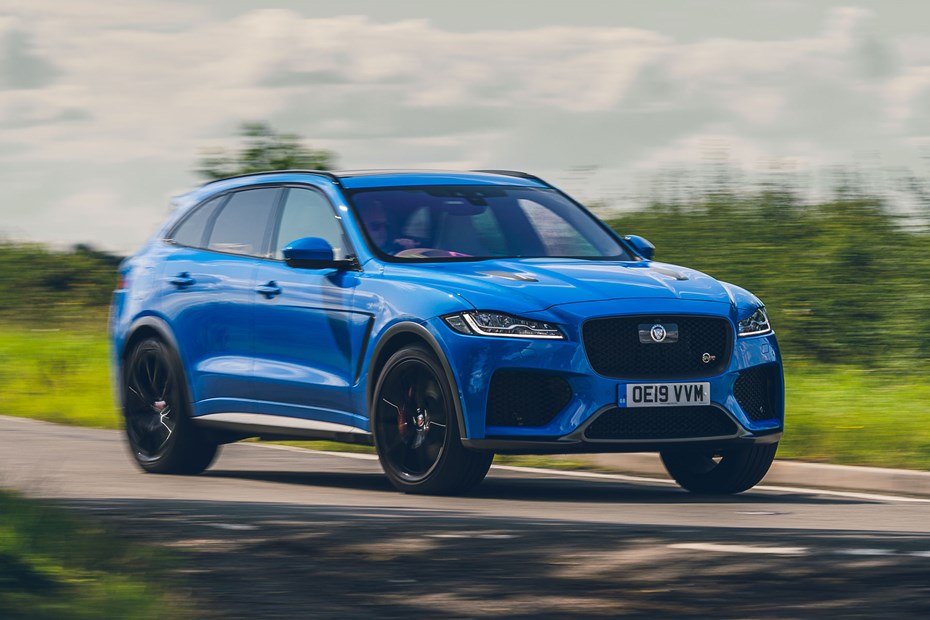
- Broad range of petrol and diesel engines plus plug-in
- All-wheel drive only
- V8 engine provides the most thrills
Petrol engines
You’ve a choice of two ‘normal’ petrol engines in the F-Pace SVR.
The entry-level, and most conventional, is badged P250. With 250hp and a 0-62mph sprint of just 7.3 seconds, it’s no slouch, with off-the-line acceleration aided by its all-wheel drive system. As a 2.0-litre, four-cylinder unit, it does feel rather lacking in grandeur for a driver-focused car like the F-Pace, but if your needs are undemanding then it will suit quite well. Don’t expect stellar fuel economy, though – you’ll average around 30mpg in mixed conditions.
The second petrol engine is exclusive to the 400 Sport model. Badged P400, it’s a rather more serious piece of business, sporting a 3.0-litre capacity and six inline cylinders to produce 400hp. The 0-62mph sprint is dispatched in just 5.4 seconds, which is real hot hatchback pace, and the 400 Sport trim level it’s attached to is a particularly handsome and well-equipped line.
Diesel engines
You’ve two diesel engines to choose from – like the petrols, there’s an entry-level 2.0-litre four-cylinder and a beefier 3.0-litre six-pot.
The former is badged D200 and produces 204hp. It’s by some stretch the most efficient engine offered in the F-Pace according to WLTP figures, and with mild hybrid assistance and the well-tuned eight-speed automatic it’s still no slouch. 0-62mph takes 8.2 seconds. The four-cylinder clatter doesn’t feel especially premium, but it’s well isolated most of the time.
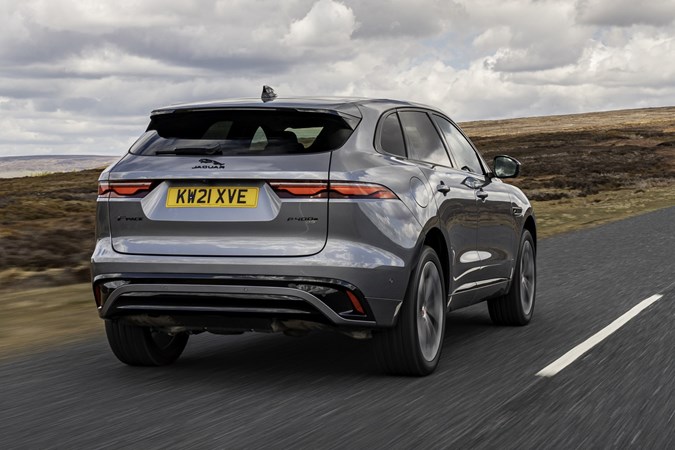
Our pick of the diesels, though (and probably our pick of the engines overall) is the D300. It feels as premium as the D200 does budget, with its smooth six-cylinder a big step up in performance and refinement. You get 300hp, and 0-62mph in 6.4 seconds. It’s quite a large leap in price from the D200, though.
Plug-in hybrid engines
The P400e uses a 2.0-litre 300hp petrol engine combined with an electric motor to produce a combined output of 404hp and 640Nm of torque. This is one brisk hybrid capable of sprinting from 0-62mph in 5.3 seconds and reaching 149mph.
If you think this PHEV is solely focussed on maximising fuel economy figures, think again. Even the electric motor produces 143hp and 275Nm of torque when driving in electric-only mode, so it’s perfectly sufficient for town use.
Integration of the different power sources is smooth and unjarring in most situations. However, brake feedback could do with some finer tuning, something in fair to Jaguar a lot of plug-in hybrids suffer from. It’s often difficult to gauge just how hard you need to press the middle pedal in order to get the amount of stopping power you require.
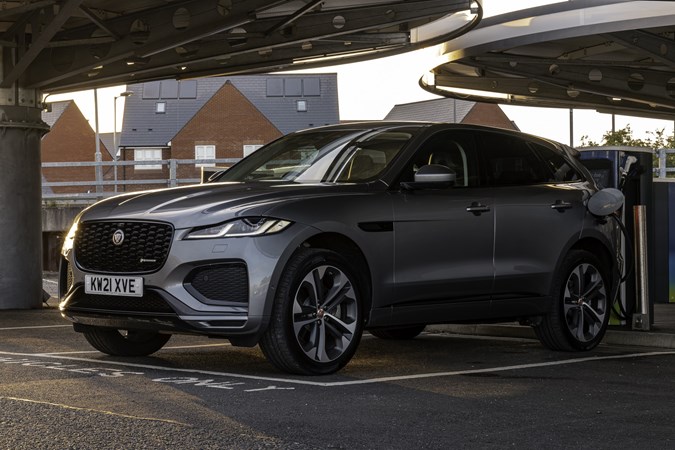
Out on the A and B roads that link towns and villages, surely where Jaguar SUVs will spend a great deal of time, the F-Pace hybrid excels. Considering the size and weight of the thing it treads lightly. It doesn’t feel as pothole-inducing as other plug-in hybrid SUVs.
Like with the rest of the F-Pace’s range, the eight-speed ‘box is very hard to trick and responds quickly to paddle shift requests.
The 0-80% charging sprint is dispatched in 30 mins on one of those fast chargers you’ll find at motorway services, or around 1 hour 40 minutes from a home charger.
High-performance engines
The final engine is like the 400 Sport with bells on. The F-Pace SVR is almost a standalone model, a rival for the likes of the Mercedes-AMG GLC 63 or Alfa Romeo Stelvio Quadrifoglio. It’s powered by a mammoth, 5.0-litre supercharged V8 that goes like the clappers and has the noise to match. It barks into life at startup, rumbles away when driving slowly and bellows like an operatic baritone when you’re really going for it.
It feels fast. Ballistic, in fact. The benchmark 0-62mph sprint takes just 4.0 seconds. Top speed (if you can find a long enough stretch of deserted runway) is 178mph. Those are supercar numbers, from a sensible family SUV. This engine feels like a perfect match for the F-Pace.

Of course, you’ll pay for it – the SVR is by some stretch the most expensive F-Pace you can buy – and fuel economy in the teens is the rule rather than the exception. But we reckon it’s well worth it.
What’s it like to drive?
- One of the sportiest SUVs to drive
- Confidence-inspiring steering set-up
- Feels more composed on the smaller wheels
As you’d expect, the engineers charged with perfecting the Jaguar F-Pace have done a great job with its dynamics. Unlike a Land Rover or Range Rover, which has to have great off-roading capability in its DNA, the F-Pace doesn’t carry this baggage, and therefore should be treated as an off-roader in as much as it will tow a horse box up a muddy hill, and complete a little light green-laning, ably assisted by its intelligent all-wheel drive system.
On road is where it matters to the F-Pace (and where most SUV buyers spend their time anyway) and that’s where it scores well. It’s blessed with good steering and a suspension set-up that’s capable of delivering great cornering once you’re used to the lofty driving position.
The F-Pace is sharp to drive regardless of specification. It manages this through a clever set of chassis components that work in harmony to provide a rear-wheel drive character for the most part, only diverting up to half the available torque to the front wheels when the car senses it’s required.

There’s a titanic amount of grip on offer. No matter how quickly you corner we doubt you’ll test the extremities of the wide tyres’ adhesion and the F-Pace’s composure is more apparent with the taller sidewalls you get on smaller wheels.
Its steering is finely honed, with enough feedback to inspire confident cornering and weighting that feels natural in all situations. The handling balance is great too, which further adds to the assured nature of the F-Pace. It always feels solid and composed – valuable peace of mind for the sorts of families who will buy this car.
The F-Pace SVR has been tuned for keen drivers, and is the best model in the range for those who value steering feel, decent handling and a sporting drive. Despite tipping the scales at almost two tonnes, it’s agile on the road, and is ably assisted by the active electronic differential, which is a first for Jaguar. For those who don’t need to know how the diff works, the easiest thing to remember is that the most power will always go to the wheel with the most traction – thus aiding confidence.
Happily, the driver doesn’t need to know what’s happening, how it works, or fiddle with settings. It handles well regardless – the accurate, sweet, not-over-assisted steering is a delight to experience, even if it’s not quite as overtly sporting as the Alfa Romeo Stelvio Quadrifoglio.
We’ve also driven this SUV on the rough stuff and can confirm it’s extremely capable, tackling far tougher terrain than Porsche dared to subject the Macan to when it was launched. You’d expect that, frankly, because don’t forget this is the same organisation that builds the Land Rovers that lead the field in this respect.
You don’t get quite as many off-road-centric features on the road-biased Jaguar, but you could hardly call it lacking either. We were particularly impressed with the All Surface Progress Control (ASPC) system, which acts like cruise control for off-road driving. Set it to any speed up to 19mph and it’ll take care of the car’s speed for you, leaving you to operate the steering.


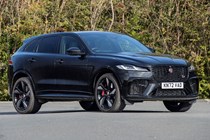
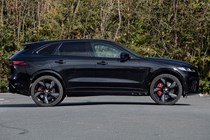
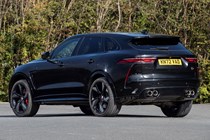
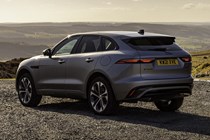
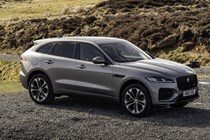
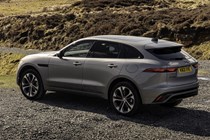
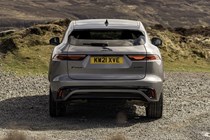
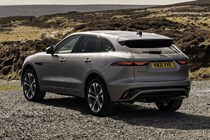

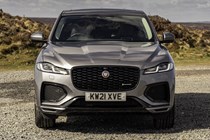

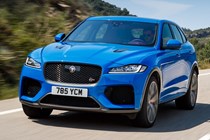
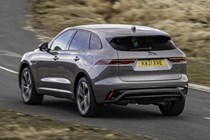
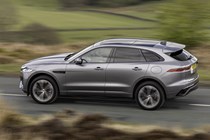
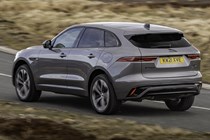
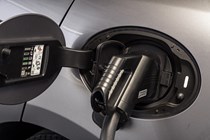

.jpg)
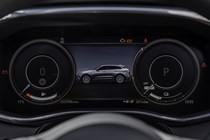

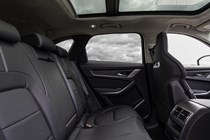
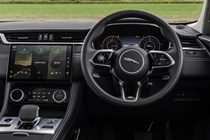
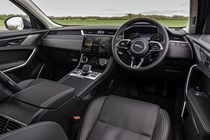
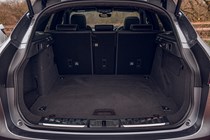
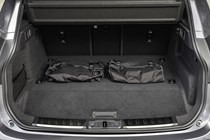

















.jpg?quality=50)






